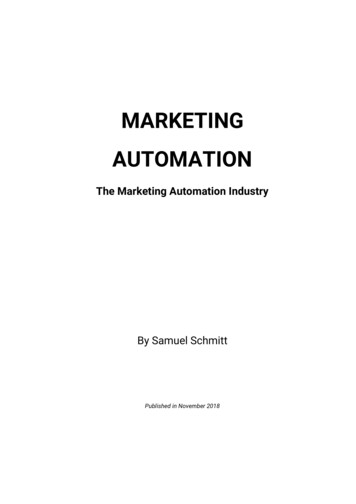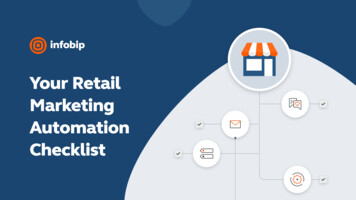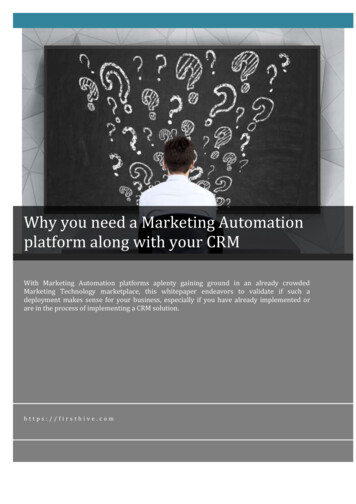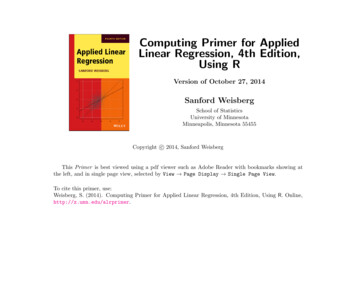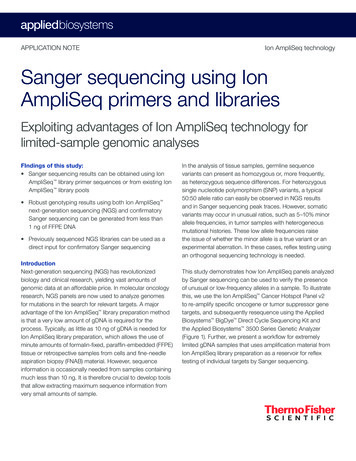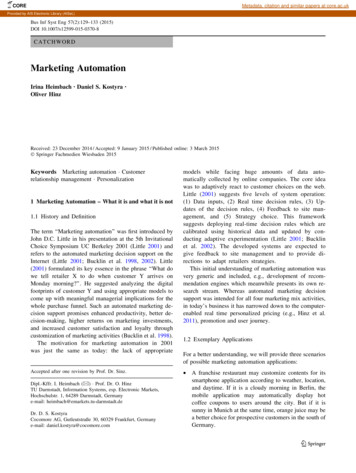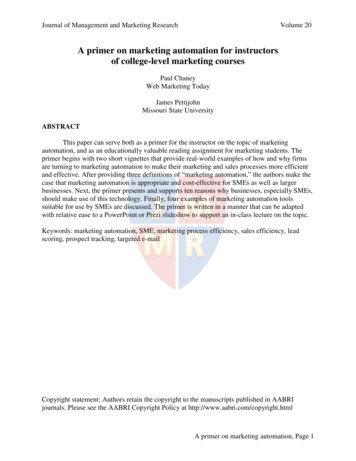
Transcription
Journal of Management and Marketing ResearchVolume 20A primer on marketing automation for instructorsof college-level marketing coursesPaul ChaneyWeb Marketing TodayJames PettijohnMissouri State UniversityABSTRACTThis paper can serve both as a primer for the instructor on the topic of marketingautomation, and as an educationally valuable reading assignment for marketing students. Theprimer begins with two short vignettes that provide real-world examples of how and why firmsare turning to marketing automation to make their marketing and sales processes more efficientand effective. After providing three definitions of “marketing automation,” the authors make thecase that marketing automation is appropriate and cost-effective for SMEs as well as largerbusinesses. Next, the primer presents and supports ten reasons why businesses, especially SMEs,should make use of this technology. Finally, four examples of marketing automation toolssuitable for use by SMEs are discussed. The primer is written in a manner that can be adaptedwith relative ease to a PowerPoint or Prezi slideshow to support an in-class lecture on the topic.Keywords: marketing automation, SME, marketing process efficiency, sales efficiency, leadscoring, prospect tracking, targeted e-mailCopyright statement: Authors retain the copyright to the manuscripts published in AABRIjournals. Please see the AABRI Copyright Policy at http://www.aabri.com/copyright.htmlA primer on marketing automation, Page 1
Journal of Management and Marketing ResearchVolume 20INTRODUCTIONAs the following paragraph documents, marketing executives at top firms in the U.S. andE.U. are realizing that they must cultivate close working relationships with their informationtechnology (IT) departments so that they can efficiently enhance the effectiveness of theirmarketing endeavors. A prime motivating factor behind this reality has been the rapid andcontinued development of marketing automation. Since this topic ordinarily receives either no, orat the most limited coverage in most entry-level college marketing textbooks, the authors providehere a primer on marketing automation. While the focus of this primer is on the marketingautomation opportunities available to small- and medium-sized enterprises (SMEs), thediscussion can easily be expanded to include the use of marketing automation by large firms.COLLABORATION BETWEEN MARKETING AND ITAccording to eMarketer, a recent survey of marketing managers in the U.S., France,Germany, and the U.K., 39 percent of those involved with business-to-consumer (B2C)marketing said they already have a fully collaborative relationship with their IT department, 27percent said they should have such a relationship with IT within the next 12 months, and another15 percent said their relationship development with IT will take between one and two years.Thus, 81 percent of survey respondents indicated that they either already have a collaborativerelationship with IT, or plan on developing such a relationship in the near future. Regardingthese results, eMarketer says, “Working together with tech departments is a must-do formarketers, especially as marketing automation and other marketing technology applicationsbecome more prevalent” (eMarketer, 2015; emphasis added).MARKETING AUTOMATION IN ACTIONA recent Google search on the term, “marketing automation case study” returned 1,470results. Two of these have been digested into relatively brief vignettes to demonstrate why theuse of marketing automation is becoming increasingly prevalent.Lead Scoring and Nurturing at McAfeeCRM Technologies’ Marketing Operations reports that the market-leading securitytechnology firm, McAfee, realized that its revenue growth was the result of close collaborationbetween its sales and marketing teams (CRMT, 2012). Over time, however, those in salesbecame disenchanted with the quality of many of the leads that were being sent to them frommarketing’s multi-channel lead generation programs, and began to believe that it was not worththe effort to follow up some of them. This situation caused marketing to realize that, while thevolume of leads was outstanding, it would be quite beneficial to develop an automated approachto evaluating (or scoring) responses to its various programs so that only “quality leads” were sentalong to sales. Those leads that fell below the quality threshold would not discarded, however;instead, marketing viewed them as ideal for candidates for nurturing through what might becalled a “quality-enhancing journey.” Marketing envisioned this program as one that wouldprovide the nurtured with “the right information at the right time in the buying process to enableleads to becoming sales-ready over time “ (CRMT, 2012). To fulfill its vision, McAfeeA primer on marketing automation, Page 2
Journal of Management and Marketing ResearchVolume 20eventually used CRM Technologies’ Eloqua software and services to develop a sophisticatedlead scoring and nurturing program for its worldwide operations. The result not only has been amore harmonious working relationship between McAfee marketing and sales, but also 35 percentfewer, albeit more highly qualified, leads and a fourfold increase in conversion rate. (A detailedcase study can be found at CRMT, 2012.)Increasing Marketing Productivity at LeanLogisticsOn its website, Marketo tells of its relationship with LeanLogistics, a leading developerof applications for supply chain and transportation management systems (Marketo, 2015). Thecompany, whose clients include such firms as The Dannon Group and Ace Hardware, assists itsclients with increasing supply chains efficiencies and also helps shippers, carriers and others withcost reduction, service improvement, and supply chain visibility. LeanLogistics had been usingan outdated marketing automation system, which was manually integrated with Salesforce.com,but realized that a state-of-the art system was required for increased growth. The company’sresearch led them to choose Marketo’s marketing automation solution because of its perceivedcapabilities, customization features, value, and ability to integrate with Salesforce.com. By theend of the first week with Marketo, LeanLogistics was launching marketing campaigns for bothwebinars and trade shows. The company says that, while those campaigns previously had taken 2to 3 days to put together, they only took 2 hours to launch with Marketo. Webinars andtradeshows that formerly required 6 weeks to prepare, took just one day with Marketo. Theseefficiencies allowed LeanLogistics to substantially increase not only the number (twice thenumber of campaigns created in the same amount of time), but also what it views as the quality,of the campaigns it is launching. Furthermore, by using Marketo’s “task” function,LeanLogistics marketers can observe lead progression and increase conversion rates. Finally,Marketo’s features also allow LeanLogistics to maintain all of its webinar and tradeshowregistrants in one place, allowing the company to track all communication and feedback relatedto its events in increased detail. LeanLogistics’ marketing team believes that Marketo has givenit the ability to develop powerful, mutually beneficial working relationships with both their salesand client services teams. (A detailed case study can be found at Marketo, 2015.)MARKETING AUTOMATION: WHAT IS IT?Marketing Automation Times says that “Marketing automation focuses on thedefinition, scheduling, segmentation, and tracking of marketing campaigns (with the objective ofmaking) processes that would otherwise be performed manually much more efficient, and(making) new processes possible” (MarketingAutomationTimes, 2015). The Content MarketingInstitute explains that marketing automation “ takes traditionally manual tasks and, well,automates them; (thus), activities such as contact management, list segmentation, lead scoringand nurturing, A/B testing of website pages and offers, email marketing, and performancemeasurement and reporting can all be done more efficiently through automation.” (Roetzer,2014). And finally, Sales Lead Insights states that “Marketing automation is the use oftechnology to generate, nurture, score and qualify leads, and drive sales using customized, multitouch marketing communications that are tailored for each contact’s profile, level of interest,behavior, or place in the buying process” (Macintosh, 2010).A primer on marketing automation, Page 3
Journal of Management and Marketing ResearchVolume 20The common thread that seems to run through these three definitions, as well as the manyothers one can locate online, is that marketing automation streamlines the various marketingprocesses by using technology to automate marketing-related tasks that formerly wereaccomplished manually.MARKETING AUTOMATION: BY THE BIG AND FOR THE BIG?The majority of the 1400 marketing automation case studies that the authors locatedonline discuss how large providers of enterprise marketing automation solutions -- Hubspot,Marketo and Pardot are the market share leaders (Alp Mimar, 2015) -- were able to help avarious relatively large businesses streamline their marketing processes. This fact begs thequestion, “Is marketing automation only for large companies?” As demonstrated below, theanswer to that question is, “No.” That is, while marketing automation, because of its high cost,originally might have been reserved for larger firms, lower-cost platforms that are more suitablefor the budgets of small- and medium-sized enterprises (SMEs) continue to come on the market.The remainder of this paper discusses why SMEs should use marketing automation andsummarizes the features of four web marketing automation tools suitable both in scope and incost for use by smaller firms.MARKETING AUTOMATION: REASONS SMES SHOULD USE ITWhy are more and more businesses using, or considering using, marketing automation?More specifically, why should an SME consider its use? The following paragraphs discuss tenpotential answers to these questions.Marketing Automation Combines Marketing FunctionsMarketing automation platforms can combine a company’s various customer acquisitionand retention channels. Thus, with marketing automation, a single software suite is managingsuch activities as email, social media, landing pages, webinars, and even offline activities likedirect mail. Combining these channels can be a time-saver for the marketer, and might even be acost-saver, if the firm formerly was paying for separate platforms to manage these tasks.Marketing Automation Integrates Marketing ChannelsCombining marketing channels has its benefits, but marketing automation also offers theopportunity to integrate them as well. The result: rather than launching incohesive campaignsthrough isolated “silos” within the organization, marketing automation can make a firm’smessaging uniform across the many channels it uses to “get out the word.”Marketing Automation Supports the Customer “Journey”Prospects do not always click the “Buy Now” or “Subscribe” button the first time theyhear a business’ marketing message. When that is the case, the marketer needs to lead themalong a path as they journey from prospects to buyers. Along that path, the marketer wants tocreate as many touch points as possible with the objective of leading prospective customers inA primer on marketing automation, Page 4
Journal of Management and Marketing ResearchVolume 20the right direction. Marketing automation allows marketers to design, or map out, those touchpoints along the prospect’s journey so that marketing messages that are timely and relevant canbe delivered. Ultimately, of course, the desire is for the prospect to initiate actions (i.e.,completing a web form), which can lead to real-time interaction when the prospective customeris ready to buy. A marketing automation platform can design and track all these activities.Marketing Automation Offers a Comprehensive ViewWhen the data from a variety of touch points are integrated, the marketer obtains an allinclusive view of the customer/prospect. For example, Woopra builds a comprehensive profilefor each prospect/customer, and then allows the marketer to synchronize customer data and trackcustomer activity information the firm’s website and mobile application, email activity, helpdesk contacts, live chat, and other touch points (Whoopra, 2015). This type of comprehensiveinformation would be quite difficult, if not impossible, to obtain if each bit of informationresided on its own platform. With marketing automation, information from each touch point isfed into the profile for each customer/prospect. This comprehensive information, in turn, can beused to create and send custom targeted marketing materials and campaigns.Marketing Automation Tracks, Nurtures, and Qualifies LeadsMost marketing automation software platforms have a customer management componentthat can be employed to track, nurture, and qualify leads, with the objective of closing moresales. For example, the Leads and Sales Pipeline from InTouch allows the marketer “to manageopportunities through (the firm’s) sales funnel, from initial contact through to a win or loss”(InTouch, 2015a). Many customer management tools can also be used to project revenue growthand more accurately manage cash flows.Marketing Automation Produces Detailed ReportsThe fact that marketing automation platforms integrate marketing channels gives the userthe ability to track all of their firm’s marketing activities and generate custom reports that detailresults. While individual platforms, such as Google AdWords, have reporting functions, theycannot integrate information to the same degree and detail that marketing automation platformscan. For example, Infusionsoft’s Dashboard can, in one place, report such items as email openrates, email click-throughs, new contacts, new qualified leads, opt-outs, email broadcasts sent,number of active webforms, contacts captured by web forms, and active automation links(Infusionsoft, 2015a).Marketing Automation Fosters Coordination between Marketing and SalesWhen marketing and sales are not coordinated, leads generated by marketing campaignsmay not be efficiently converted into revenues by sales. Marketing automation can helpremediate this problem by providing the same information to both marketing and sales.Ordinarily, the provision of this data is accomplished through a marketing automation platform’scustomer-management tool. This data can be used by marketing to create customer profiles andmarketing materials designed for each customer and/or prospect persona. Furthermore, sales canA primer on marketing automation, Page 5
Journal of Management and Marketing ResearchVolume 20use the data to help qualify individual prospects with regard to their purchase readiness, and thencan jointly work with marketing to move each prospect along a journey to buying. (For anexample of this coordination at work, see the above McAfee vignette.)Marketing Automation Can Reduce the Learning CurveWhen any business function employs a variety of disparate software packages, muchvaluable time must be invested in learning how to use each one. With marketing automation, onthe other hand, there is only one platform to master; thus, the learning curve is reduced.Additionally, most marketing automation packages designed for SMEs are quite user-friendly;that is, they do not require the user to understand software design, how to use HTML, or masterother software development skills. In fact, a number of these platforms include ready-made,easy-to-use templates that can be customized with the SME’s own branding.Marketing Automation Increases PersonalizationThe sceptic might contend that marketing automation makes dealings withcustomers/prospects quite impersonal, and that is a fair argument since automation cannotsubstitute for face-to-face dealings with customers and prospects. On the other hand, marketingautomation facilitates the tracking of such valuable information as the marketing and othercontent consumed by customers/prospects, the keywords for which they search, the emails theyhave opened and clicked on, and even their interactions with the business on social media. Whenthis information is aggregated and analyzed for each customer/prospect, the business can thentarget individuals and market segments with offers and other marketing messages that arepersonalized to their demographics, interests, online behavior, goals, etc.Marketing Automation Makes Marketing More ProductiveWhile individual specialized tools, such as email marketing platforms, might do somethings better than marketing automation services, the time-savings offered by the latter canovershadow any lack of functionality. Being able to perform more marketing tasks in the timeavailable makes the marketing function more productive and potentially more effective, as wasdemonstrated by the two introductory vignettes included earlier in this paper.MARKETING AUTOMATION: FOUR EXAMPLESOF PLATFORMS FOR SMALL BUSINESSESAs can be discerned from the preceding discussion, marketing automation platforms offermuch potential to assist SMEs with their marketing efforts. And, as was mentioned above, todaythere are a number of affordable, user-friendly packages on the market. Each of these has theability to combine several marketing functions under a single interface, and that can be a realtime-saver in the world of business where, as the saying goes, “time is money.” The followingparagraphs summarize the features included in four marketing automation tools that are suitablefor SMEs.A primer on marketing automation, Page 6
Journal of Management and Marketing ResearchVolume 20InTouchInTouch (http://www.intouchcrm.com) calls itself “The All-in-One Email Marketing &CRM System for Your Growing Business,” and says that it “ provides everything you need inone place to manage the acquisition and nurturing of new and existing customers (InTouch,2015b).” The InTouch platform includes the following components: A contact management database designed to be the starting point for all marketing andcustomer communications. It is designed to simplify the task of sending the correct messagesto the correct people in a timely manner. An e-mail marketing tool that allows users to “build relationships, send offers to the rightpeople at the right time, track response rates and follow up.” An automated campaigns feature, which allows businesses to build and automatically sendout predefined emails to educate, sell, say thank you, gain feedback, etc. A web forms tool designed to make it simple for customers/prospects to self-add theirinformation to the business’ contact database, as well as to easily subscribe to the firms’email lists. Tasks such as sending out follow-up emails, grouping contacts, ensuring contactfollow-up, advancing leads to the sales pipeline and others can all be automated. A marketing survey tool allows the marketer to quickly develop custom online surveys thatcan be distributed to contacts by means of an email campaign. An social media management feature that allows the user to manage all the firm’s socialmedia interactions from a single interface. Tweets can be sent with just one click. Thebusiness’ Facebook profile and other information can be maintained from within InTouch.Email campaigns can be tweeted to let contacts know what those campaigns are saying.Social sites can be added to email campaigns to make it simpler for contacts locate thebusiness’ Facebook and Twitter pages, and contacts can be directly imported into theInTouch database from the firm’s Twitter account. A text messaging tool, which allows the marketer to send text messages directly to customerswho have agreed to receive them (i.e., those who have opted in). This feature is quitepowerful because the marketer knows that texts ordinarily get read. An easy-to-use drag and drop sales pipeline management tool that gives the marketer acentral interface that can be used to track prospects from the first contact through to a sale, orother event viewed as a success. An interactive shared calendar to facilitate time management without the need for additionalsoftware. This online team calendar allows the user to maintain all appointments, meetingsand projects, establish deadlines, and generate automated task reminders, all of which areshared with any team members in real time.The reader can learn about the cost of InTouch at: alesAutoPilot (www.salesautopilot.com) bills itself as “the world's most sophisticatedyet easy to use "all-in-one" marketing and sales machines (that provides) professional emailmarketing, CRM, multi-channel communication and e-commerce (Sales Autopilot, 2015).”The platform, which is primarily intended for businesses involved with e-commerce, is modulebased and includes the following components:A primer on marketing automation, Page 7
Journal of Management and Marketing ResearchVolume 20The “Marketing Autopilot” is an e-mail marketing tool with a number of features. It allowsthe marketer to easily prepare and distribute surveys, polls, email newsletters, andtransactional emails, to set up automatic responses to incoming emails, to segment mailinglists according to pre-defined criteria, and to conduct A/B split testing. In addition, it can beintegrated into Google Analytics. The platform’s “Ecommerce” component provides SKU management, order form creation,personalization features, order tracking, a variety of payment options including PayPalintegration, shipping options, and integration with Google Analytics. The “Multichannel Communication” component is capable of sending text messages, directmail, and conducting telemarketing campaigns. The “Customer Management” module gives the marketer a complete contact/customerhistory, the ability to schedule tasks and event, and access to sales activity reports. It also canbe integrated with Google Contacts.The pricing structure for Sales Autopilot can be found at: http://www.salesautopilot.com/prices#.Vj9wi mrS70 . InfusionSoftInfusionsoft says that its sales and marketing platform can be used to help “harness thepower of automation to organize contacts, turn leads into customers and transform customersinto raving fans like no other software on the market (InfusionSoft, 2015b).” The platformincludes a number of marketing automation features, including the following: A customer management component designed to allow the marketer to organize contacts inways that lets him/her become more familiar with customers/prospects, so that theirindividual needs can be addressed. An email marketing tool, which gives the marketer the ability to “trigger personalizedcommunications based on email sends, opens, clicks, form submissions, and payment history,so (the marketer knows) messages will be timely and relevant to customers' needs(Infusionsoft, 2015b).” Ecommerce shopping carts A contact organization feature that, among other things, allows the marketer to segment andtag customers/leads for personalized follow-up. A lead database that gives the marketer the ability to collect data about the behaviors ofleads. A lead scoring feature that allows the marketer to generate a lead-quality score based oninteractions with the company and its marketing campaigns. A lead prioritization tool that lets marketing and sales classify leads based on how ready theyare to buy. A customizable Homepage dashboard that can be designed to suit the roles andresponsibilities of each user of the platform by means of a variety of drag-and-drop widgetsthat quickly give access to reports, statistics, and other information the user considers beinghigh-priority.Infusionsoft also offers at no cost, and in advance of contracting for its services, what itcalls its “Sales and Marketing Scorecard, which assesses which of a firm’s marketing strategiesare effective and which are not. The Scorecard appraises the marketer’s sales and marketingA primer on marketing automation, Page 8
Journal of Management and Marketing ResearchVolume 20based on how effectively they attract leads, increase the customer base through follow-ups, andcultivate customer loyalty. Information on Infusionsoft’s pricing structure can be found ��s homepage (http://www.yodle.com) makes the following promise to businessesconsidering its use: “Find and keep more customers in just a few minutes a week. See why50,000 small business owners trust Yodle with their local online marketing (Yodle, 2015).”Yodle’s marketing automation platform, “Marketing Essentials,” combines the followingfunctions into a single integrated package: Website construction and optimization Listing in more than 50 business directories Search engine placement and search engine optimization (SEO) Construction and maintenance of a Facebook business presence Quick creation and distribution of special offers to the business website, Facebook Businesspage, to 50 business directories, and via email to existing customers Simple creation and distribution of emails – appointment reminders, thank you notes,newsletters, holiday greetings, promotional messages, etc.While Yodle does not publish its pricing structure on its website, one can learn about it byphoning one of its marketing consultants at: 888-724-9963.SUMMARYThis paper was written as a primer for instructors of college-level marketing courses whowish to enhance their knowledge of the increasingly important field of marketing automation.The primer begins with two short vignettes designed to provide real-world examples of how andwhy firms are turning to marketing automation to enhance both the effectiveness and efficiencyof their marketing and sales processes. Next, this primer provides three definitions of “marketingautomation,” whose common thread is that it streamlines the various marketing processes byusing technology to automate marketing-related tasks that formerly were accomplishedmanually. After briefly making the case that marketing automation is appropriate and costeffective for SMEs as well as larger businesses, the primer discusses ten reasons why SMEsshould make use of this technology. Finally, four examples of marketing automation toolssuitable for use by SMEs are discussed.The authors wrote this paper with the vision that it could serve both as a primer for theinstructor and as an educationally valuable reading assignment for students in his/her marketingclasses. Finally, the authors endeavored to write this primer in a manner that can be adapted withrelative ease to a PowerPoint or Prezi slideshow to support an in-class lecture on the topic.ReferencesAlp Mimar (2015), “The top 7 marketing automation companies of Q1 2015,” document on theInternet ion-companies-of-q12015/), 6 February, accessed November 1, 2015.A primer on marketing automation, Page 9
Journal of Management and Marketing ResearchVolume 20CRMT (2012), “CRM Technologies helps McAfee to reap the benefits of Lead 'Temperature'with Eloqua's Lead Scoring & Lead Nurturing,” article on the perature-eloquas-lead-scoring-lead), accessed October 27, 2015.eMarketer (2015), “Marketers Are Working on Their Relationships with IT,” article on theInternet g-on-Their-Relationshipswith/1013103?ecid NL1001), accessed October 15, 2015.Infusionsoft (2015a), “Customize the Homepage Dashboard,” article on the me-page-dashboard), accessed October 28, 2015.Infusionsoft (2015b), “Sales and Marketing Software for Small Business,” document on theInternet (http://www.infusionsoft.com/features/overview), accessed November 1, 2015.InTouch (2015a), “Drag and Drop Sales Pipeline,” document on the opportunity-management/), accessed October28, 2015.InTouch (2015b), “The All-in-One Email Marketing & CRM System for Your GrowingBusiness,” article on the Internet (http://www.intouchcrm.com), accessed October 31,2015.Macintosh, M. (2010), “B2B Marketing Automation: Here’s My Definition,” Sales LeadInsights, March 9, article on the Internet ing-automation-definition/), accessed October 28, 2015.Marketing Automation Times (2015), “Marketing Automation Definition,” article on the -us/marketing-automation-definition/),accessed October 28, 2015.Marketo (2015), “Case Study: LeanLogistics,” article on the stics/), accessed October 28, 2015.Roetzer, P. (2014), “15 Ways Marketing Automation Can Maximize Your Content’s ROI,”Content Marketing Institute, January 9, article on the /01/marketing-automation-maximize-contentroi/), accessed October 28, 2015.SalesAutoPilot (2015), “Put Your Sales On Autopilot,” document on the Internet(http://www.salesautopilot.com/), accessed November 1, 2015.Whoopra (2015), “Take Control of Your Customer Data,” article on the Internet(https://www.woopra.com/platform/), accessed October 28, 2015.A primer on marketing automation, Page 10
Journal of Management and Marketing ResearchVolume 20Yodle (2015), “Yodle,” article on the Internet (http://www.yodle.com), accessed October 31,2015.A primer on marketing automation, Page 11
such activities as email, social media, landing pages, webinars, and even offline activities like direct mail. Combining these channels can be a time-saver for the marketer, and might even be a cost-saver, if the firm formerly was paying for separate platforms to manage these tasks. Marketing Automation Integrates Marketing Channels

